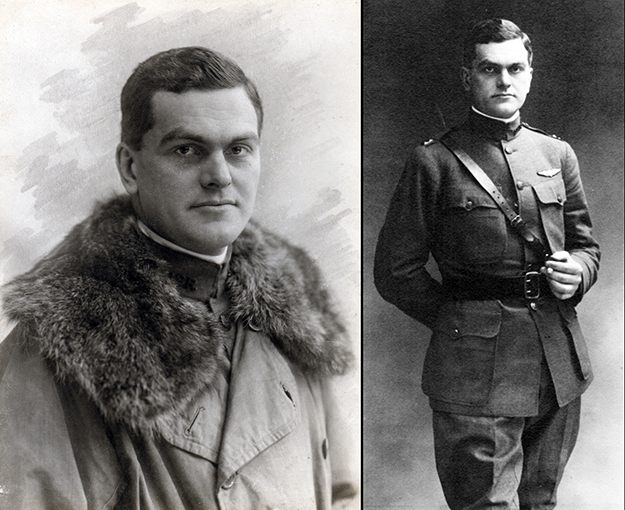| |
Fallen World War I Aviator Gets Posthumous Distinguished Flying Cross
By C. Todd Lopez

Army Capt. James E. Miller served as a pilot during World War I, and was the first U.S.-trained pilot to be a combat aviation casualty of the war. The Army awarded him the Distinguished Flying Cross, and presented the posthumous award to his great-grandson during a twilight tattoo event, June 14, 2017, at Joint Base Myer-Henderson Hall, Va. Courtesy photo
|
|
WASHINGTON — Army Capt. James E. Miller, one of the first aviators in the U.S. military and the first U.S. aviation casualty in World War I, has been named recipient of the Distinguished Flying Cross nearly 100 years after his heroic actions over France in 1918.
On the 242nd birthday of the Army, during a twilight tattoo ceremony at Joint Base Myer-Henderson Hall, Virginia, Acting Secretary of the Army Robert M. Speer presented the Distinguished Flying Cross to Miller's great-grandson, Byron Derringer.
“We're very proud today to have some of the descendants from James Miller's family here and able to represent him and a lineage of what he achieved on those battlefields as the first individual who gave his life in that war in aviation," Speer said.
The presentation of the cross to a World War I soldier is significant, given that the theme for this year's Army birthday is, "Over There! A Celebration of the World War I Soldier."
America Enters World War I
The United States declared war on Germany on April 6, 1917. On Dec. 7, 1917, the U.S. declared war on Austria-Hungary, Germany’s ally.
"This is the 100th anniversary of [America’s entry into] World War I," Speer said. "And it's the 242nd birthday of our Army. But 100 years ago, there were significant changes in terms of the character of war. You had at that time, for the first time, the Army going off to war in foreign lands with our allies, fighting side-by-side with our allies, and representing the United States -- which placed the United States into a significant leadership role in the world."
Speer said several aspects of warfare changed during World War I, including the development of armor units and precision artillery. One of the most significant developments, however, was that the U.S. military had "aviation for the first time as part of the U.S. Army Air Corps," he said.
"We have a privilege today to be able to recognize not only the heraldry of our total 242 years but also that point and time, where we recognize, late, a Distinguished Flying Cross for an American hero," Speer said.
Early 20th Century Aviation Warfare
As a soldier in World War I, Miller was one of the first to make use of new aviation technology. The captain took command of the 95th Pursuit Squadron on Feb. 10, 1918 -- just 10 months after the United States declared war on Germany. The men in the squadron were the first American-trained pilots to fight in the war.
On March 9 of that year, Miller, Maj. M. F. Harmon and Maj. Davenport Johnson began the first combat patrol ever for the U.S. Army Air Services. They flew 180-horsepower, French-built SPAD XIII aircraft. The aircraft, a biplane, is named for its developer, the Société Pour L'Aviation et ses Dérivés.
Harmon's plane experienced trouble early in the sortie, and so he was unable to continue on the patrol. But Miller and Johnson pressed on together and crossed into enemy territory. There, they fought off two German aircraft, but soon met more. It was then that Johnson's aircraft experienced trouble with the machine guns.
Miller Fights On
According to the DFC citation, Johnson was forced to leave Miller to continue the fight against German aviators on his own.
"Miller continued to attack the two German biplanes, fearlessly exposing himself to the enemy, until his own aircraft was severely damaged and downed behind the German lines, where he succumbed to his injuries," the citation reads. "Miller's actions are in keeping with the highest traditions of the military service and reflect great credit upon himself, the United States Army Air Services and the American Expeditionary Forces."
Afterward, Derringer said of both the recognition and the twilight tattoo that accompanied the recognition, "it's spectacular, I know that the family, everybody, is just honored to be here."
Published July 8, 2017 |

